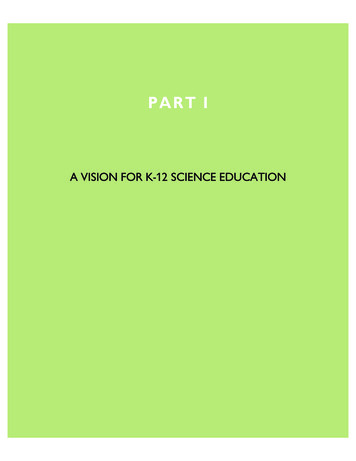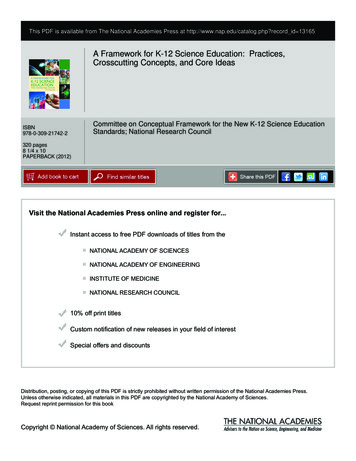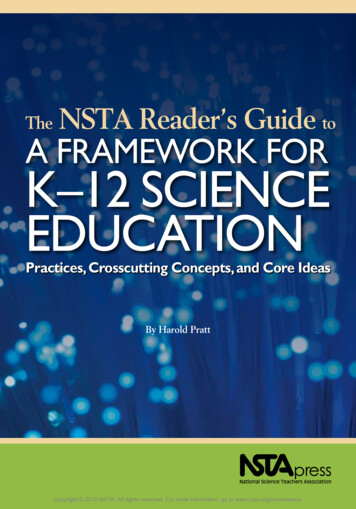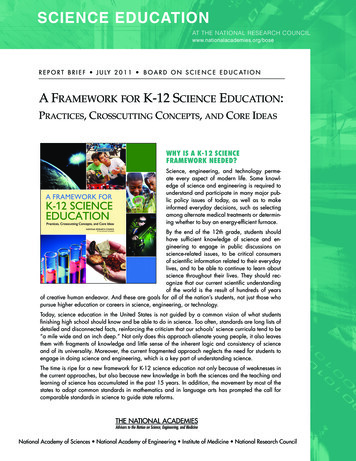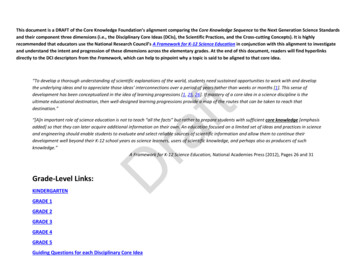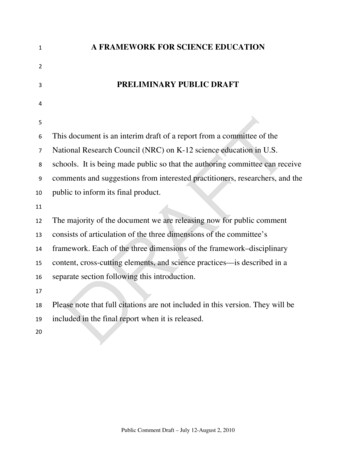
Transcription
1A FRAMEWORK FOR SCIENCE EDUCATION23PRELIMINARY PUBLIC DRAFT456This document is an interim draft of a report from a committee of the7National Research Council (NRC) on K-12 science education in U.S.8schools. It is being made public so that the authoring committee can receive9comments and suggestions from interested practitioners, researchers, and the10public to inform its final product.1112The majority of the document we are releasing now for public comment13consists of articulation of the three dimensions of the committee’s14framework. Each of the three dimensions of the framework–disciplinary15content, cross-cutting elements, and science practices—is described in a16separate section following this introduction.1718Please note that full citations are not included in this version. They will be19included in the final report when it is released.20Public Comment Draft – July 12-August 2, 2010
123456789A Framework for Science Education101112131415161718192021Preliminary Public DraftCommittee on Conceptual Framework for New Science Education StandardsBoard on Science EducationDivision of Behavioral and Social Sciences and Education222324Public Comment Draft – July 12-August 2, 2010
1iiPublic Comment Draft – July 12-August 2, 2010
0COMMITTEE ON CONCEPTUAL FRAMEWORK FOR NEW SCIENCE EDUCATIONSTANDARDSHELEN R. QUINN (Chair), SLAC National Accelerator Laboratory, Stanford UniversityWYATT W. ANDERSON, Department of Genetics, University of Georgia, Athens, GATANYA ATWATER, Department of Earth Science, University of California, Santa BarbaraPHILIP BELL, Cognitive Studies in Education, University of Washington, SeattleTHOMAS B. CORCORAN, Teachers College, Columbia UniversityRODOLFO DIRZO, Department of Biology, Stanford University, StanfordPHILLIP A. GRIFFITHS, Institute for Advanced StudyDUDLEY R. HERSCHBACH, Department of Chemistry & Chemical Biology, HarvardUniversityLINDA P.B. KATEHI, University of California, DavisJOHN C. MATHER, NASA Goddard Space Flight CenterBRETT D. MOULDING, Utah Partnership for Effective Science Teaching and Learning,JONATHAN OSBORNE, School of Education, Stanford University, StanfordJAMES W. PELLEGRINO, School of Education & Social Policy, University of Illinois,STEPHEN L. PRUITT, Office of the State Superintendent of Schools, Georgia Department ofEducationBRIAN REISER, School of Education & Social Policy, Northwestern UniversityREBECCA R. RICHARDS-KORTUM, Department of Bioengineering, Rice UniversityWALTER G. SECADA, School of Education, University of MiamiDEBORAH C. SMITH, Department of Curriculum & Instruction, Pennsylvania StateUniversityHEIDI A. SCHWEINGRUBER, Deputy DirectorTHOMAS KELLER, Senior Program OfficerMICHAEL A. FEDER, Senior Program OfficerMARTIN STORKSDIECK, DirectorKELLY A. DUNCAN, Senior Program AssistantiiiPublic Comment Draft – July 12-August 2, 2010
ivPublic Comment Draft – July 12-August 2, 2010
Contents1. Introduction: A New Conceptual FrameworkA Coherent VisionPrinciples of the FrameworkStructure of the FrameworkImplications for Standards1-21-41-101-152. Developing Goals for K-12 Science and Engineering EducationKey Elements of ScienceIntegrating EngineeringStrands of Scientific Proficiency for K-12 StudentsThe Strands and This Framework2-12-42-62-113. Dimension 1: Core Disciplinary IdeasCore Ideas in the Life SciencesCore Ideas in the Earth and Space SciencesCore Ideas in the Physical SciencesCore Ideas in Engineering and Technology3-23-73-103-144. Dimension 2: Cross-Cutting ElementsCross-Cutting Scientific ConceptsTopics in Science, Engineering, Technology, and Society4-24-195. Dimension 3: Scientific and Engineering PracticesHow Scientists and Engineers WorkPractices for Science Classrooms5-25-86. Putting the Dimensions Together: Performance ExpectationsIllustrations of Performance Expectations6-27. Prototype Learning ProgressionsArticulating the ProgressionsLife Science Prototype Learning ProgressionsEarth and Space Science Prototype Learning ProgressionsPhysical Science Prototype Learning ProgressionsEngineering and Technology Prototype Learning Progressions7-27-97-227-407-55Appendix A: Biographical Sketches of Committee MembersAppendix B: Design TeamsvPublic Comment Draft – July 12-August 2, 2010
1viPublic Comment Draft – July 12-August 2, 2010
Ch. 1: Introduction: A New Conceptual Framework1Chapter 12Introduction: A New Conceptual Framework1-1345The conceptual framework in this report presents the committee’s vision of the scope and6nature of the education in science and engineering that is needed in the 21st century. Thus, it7describes the major scientific ideas and practices that all students should be familiar with by the8end of high school. Engineering and technology are featured alongside the natural sciences in9recognition of the importance of understanding the designed world and of the need to better1011integrate the teaching and learning of science, technology, engineering, and mathematics.By a “framework” we mean a broad description of the content and sequencing for student12learning and skill development in science, but not at the level of detail of grade-by-grade13standards. This document is intended to act as a guide not only to Standards developers, but also14to curriculum designers, assessment developers, state and district science administrators, those15responsible for science teacher education, and science educators working in informal settings.16This framework is particularly timely because of a state-led national movement towards17common standards across states. The growing national consensus around the need for “fewer,18higher, clearer” is central to this effort. There is widespread recognition that too often standards19are long lists of detailed and disconnected facts, reinforcing the criticism that the U.S. science20curriculum tends to be “a mile wide and an inch deep.” Not only is such an approach alienating21to young people, but it can also leave students with fragmented elements of knowledge and little22sense of the intellectual and creative achievements of science or its explanatory coherence.Public Comment Draft – July 12-August 2, 2010
Ch. 1: Introduction: A New Conceptual Framework1Moreover, it neglects the need for students to develop an understanding of the practices of2science and engineering which is as important as knowledge of its content.1-234A COHERENT VISION56This framework is an attempt to move science education toward a more coherent vision7in three ways. First, it focuses on a limited number of core ideas in science and engineering both8within and across the disciplines. The committee made this choice to avoid shallow coverage of a9large number of topics and to allow more time for teachers and students to explore each idea in10greater depth. Reduction of the sheer sum of details to be mastered gives time for students to11engage in scientific investigations and argumentation and to achieve depth of understanding of12the material that is included.13Second, the framework is committed to the notion of learning as an ongoing14developmental progression. It is designed to help children continually build on, and revise, their15knowledge and abilities, starting from initial conceptions about how the world works and16curiosity about what they see around them. Its goal is to guide the development of students’17knowledge toward a more scientifically based and coherent view of the natural sciences and18engineering, and of the ways in which this knowledge is obtained and can be used.19Third, it emphasizes that learning about science and engineering involves the integration20of both knowledge of scientific explanations (i.e., content knowledge) and the practices needed21to engage in scientific inquiry and engineering design. The framework seeks to illustrate how22knowledge and practice must be intertwined in designing learning experiences in K-12 science23education.Public Comment Draft – July 12-August 2, 2010
Ch. 1: Introduction: A New Conceptual Framework11-3The NRC’s Board on Science Education has taken an active role in examining and2reviewing research on science learning. Research on how children learn science and the3implications for science instruction in grades K-8 was synthesized in the NRC report Taking4Science to School (NRC, 2007). America’s Lab Report (NRC, 2005) examined the role of5laboratory experiences in high school science instruction, while Learning Science in Informal6Environments (NRC, 2009) focused on the role of out-of-school experiences in science learning.7Complementing these, the report Systems for State Science Assessment (NRC, 2005) looked at8large-scale assessments of science learning, while the study Engineering in K-12 Education9(NRC, 2009) looked at the skills and learning needed to introduce students to engineering during10grades K-12. All of these NRC reports are essential input to the development of this framework.11The framework also builds on the prior work of the American Association for the12Advancement of Science (AAAS) Benchmarks for Scientific Literacy and the NRC’s National13Science Education Standards (NSES). In addition, the committee examined recent efforts,14including the Science Framework for the 2009 National Assessment of Educational Progress, the15Science College Board Standards for College Success (College Board, 2009), the National16Science Teachers Association’s Anchors project, and a variety of state and international science17standards or curriculum specifications.18Specifically, the committee was charged to develop a conceptual framework that would19identify and articulate the core ideas in science around which standards should be developed by20considering core ideas in the disciplines of science (life sciences, physical sciences, earth and21space sciences, and engineering and technology) as well as cross-cutting ideas and practices. The22committee was also charged to articulate how these disciplinary ideas and cross-cutting ideas23intersect for at least 3 grade levels and to develop guidance for implementation.Public Comment Draft – July 12-August 2, 2010
Ch. 1: Introduction: A New Conceptual Framework1-412PRINCIPLES OF THE FRAMEWORK34The conceptual framework described here is based on a large and growing body of5research on teaching and learning science. Several guiding principles drawn from what is known6about the nature of learning science underlie both the structure and content of the framework.7These include young children’s capacity to learn science, the need to develop students’8understanding over time, the importance of considering both knowledge and practices, and the9increasing importance of engineering and technology in developing understanding and using10scientific knowledge and practices.111213Children Are Born InvestigatorsChildren are born investigators, studying, thinking, and building internal models of the14world around them. Science is an extension of this natural curiosity to systematic investigation of15the material world and the development of a body of knowledge and practices. Science education16is not just a process of acquiring a body of static knowledge. It also includes developing the17ability to use tools, ranging from microscopes and rulers to computers and test tubes, and the18ability to build and explain models, make predictions, and conduct scientific inquiry. Just as19reading, writing, and mathematics involve the performance of complex practices, so does20science.21The research summarized in Taking Science to School (NRC, 2007) reveals that children22entering kindergarten have surprisingly sophisticated ways of thinking about the natural world23based on direct experiences with the physical environment, such as watching objects fall orPublic Comment Draft – July 12-August 2, 2010
Ch. 1: Introduction: A New Conceptual Framework1-51collide, and observing animals and plants. They also learn about the world by talking with their2families, pursuing hobbies, watching television, going to parks, or playing outside. As children3try to understand and influence the world around them, they develop ideas about how the world4works and their role in it.5In fact, young children’s capacity to reason scientifically is much greater than has long6been assumed. Children from all backgrounds and all socioeconomic levels show evidence of7sophisticated reasoning skills. Although they may lack knowledge and experience, they can and8do engage in a wide range of subtle and complex reasoning processes. These processes can form9the underpinnings of scientific thinking. Thus, children begin school with a set of ideas about the10physical, biological, and social worlds. By paying attention to their thinking, listening to and11taking their ideas seriously, and trying to understand their thinking, educators can build on what12children already know and can do. Children’s ideas may be more or less cohesive, and certainly13in very young children they may be underdeveloped. But these initial ideas can be used as a14foundation to build remarkable understanding, even in the earliest grades. The implication of15these findings is that the framework includes building explanations of natural phenomena as16central throughout K-1, rather than focusing on description in the early grades and explanation17only in the later grades.181920Understanding Develops Over TimeThe understandings of the world that children bring to school are a valuable foundation21for learning science. The challenge lies in how to build successfully on this foundation. In order22to develop a deep understanding of scientific explanations of the natural world, students need23sustained opportunities to work with and develop the ideas that support these explanations and toPublic Comment Draft – July 12-August 2, 2010
Ch. 1: Introduction: A New Conceptual Framework1-61understand their interconnections. Yet many science curricula consist of disconnected topics,2with each given equal priority. Too little attention is paid to how students’ understanding of an3idea can be built on from grade to grade. Often students are continually introduced to new facts4without attention to how the facts are related to each other and to the core ideas of science. As a5result many, students do not develop a deep and coherent understanding of science.6Research strongly suggests that a more effective approach to science learning and7teaching is to teach and develop systematically an understanding of the core ideas of science8over a period of years rather than weeks or months. These core ideas offer an organizational9structure for the learning of new facts, practices, and explanations, and they prepare students for10deeper levels of scientific investigation and understanding in high school, college, and beyond.11The rationale for organizing content around core ideas comes from studies that show that12one major difference between experts and novices in any field is the organization of their13knowledge. Experts understand the core principles and theoretical frameworks of their field.14Their retention of detailed information is aided by their understanding of its placement in the15context of these principles and theories. Novices tend to hold disconnected and even16contradictory bits of “knowledge” as isolated facts, and struggle to find a way to organize and17integrate them. Learning to understand science or engineering in a more expert fashion requires18development of an understanding of how facts are related to each other and to overarching core19ideas. Research on learning shows building this kind of understanding is challenging, but is aided20by explicit instructional support that stresses connections across different activities and learning21experiences.22Research also indicates that one of the best ways for students to learn the core ideas of23science is to learn successively more sophisticated ways of thinking about them over multiplePublic Comment Draft – July 12-August 2, 2010
Ch. 1: Introduction: A New Conceptual Framework1-71years. This sense of progression and development has been conceptualized in the idea of2“learning progressions”. If mastery of a core concept in science is the ultimate educational3destination, learning progressions provide a map of the routes that can be taken to reach that4destination. A well-designed learning progression will include the essential underlying ideas and5principles necessary to understand a core science concept. Learning progressions can extend all6the way from preschool to twelfth grade and beyond—indeed, people can continue learning7about core science concepts their whole lives. Because learning progressions extend over8multiple years, they prompt educators to think about how topics are presented at each grade level9so that they build on and support student learning. While there is not an extensive body of10research on how children learn engineering in K-12, it is likely that a learning progressions11approach would be beneficial for learning engineering as well. Hence, core ideas and learning12progressions related to them are key organizing principles for the design of this framework. The13tables in the next section incorporate explicitly both of these elements.141516Science Is More than a Body of KnowledgeScience is not only a body of knowledge that represents current understanding of natural17systems; it is also the practices whereby that body of knowledge has been established and is18being continually extended, refined, and revised. Both elements – knowledge and practices —19are essential. In learning science, one must come to understand both the body of knowledge and20how this knowledge is established, extended, refined, and revised. The body of knowledge21includes specific facts integrated and articulated into highly developed and well-tested theories22supported by evidence from many investigations. These theories, in turn, can explain bodies ofPublic Comment Draft – July 12-August 2, 2010
Ch. 1: Introduction: A New Conceptual Framework1data and predict outcomes of investigations. They are also tools for further development of the2subject.31-8The practices used to develop scientific theories and the form those theories take differ4from one domain of science to another, but all sciences share certain common features at the core5of their problem-solving and inquiry approaches. Chief among these is a commitment to6evidence and data as the basis of developing claims. Therefore, argumentation and analysis that7relate data and theory are essential features of science. This includes evaluation of data quality,8modeling, and development of new testable questions from theory, as well as modifying theories9as the need is indicated by the data. Scientists need to be able to examine, review, and evaluate10their own knowledge. Holding some parts of a theory as more or less established and being11aware of the ways in which that knowledge may be incomplete are critical scientific practices.12Finally, science is fundamentally a social enterprise. Scientists talk frequently with their13colleagues, both formally and informally. They exchange e-mails, engage in discussions at14conferences, share research techniques and analytical procedures, and present and respond to15ideas via publication in journals and books. In these ways scientists are members of a scientific16community whose members work together to build a body of evidence and theory.171819Connecting to Students’ Interests and ExperiencesA rich science education has the potential to capture students’ sense of wonder about the20world and spark their desire to continue to learn about science throughout their lives. Research21suggests that personal interest and enthusiasm are important for supporting children’s22participation in learning science, and may be linked to later educational and career choices. In23order for students to develop a sustained interest in science and to appreciate the many ways it isPublic Comment Draft – July 12-August 2, 2010
Ch. 1: Introduction: A New Conceptual Framework1relevant to their daily lives, classroom learning experiences in science need to connect with2students’ own interests and experiences.31-9As a strategy for building on prior interest, the core disciplinary ideas the committee4identified are accompanied by questions that students themselves may have about the world. The5prototype learning progressions are designed with an eye toward not only the knowledge6students bring with them to school, but also the kinds of questions and phenomena that are likely7to be of interest and accessible to them at different ages.89Promoting Equity10The issue of connecting to students’ interests and experiences is particularly important for11broadening participation in science. There is increasing recognition that the diverse practices and12orientations that members of different cultural communities bring to formal and informal science13learning contexts are assets on which to build. For example, researchers have documented that14children reared in rural agricultural communities who have more intense and regular interactions15with plants and animals develop more sophisticated understanding of ecology and biological16species than urban and suburban children of the same age.17Others have identified connections between children’s culturally based story-telling and18their engagement in argumentation and science inquiry, and have documented pedagogical19means of leveraging these connections to support students’ science learning and promote20educational equity. The research demonstrates the importance of enlisting and embracing21diversity as a means of enhancing learning about science and the natural world. This will be22increasingly important as U.S. society becomes progressively more diverse with respect to the23language backgrounds of students and ethnic and racial group representation in society.Public Comment Draft – July 12-August 2, 2010
Ch. 1: Introduction: A New Conceptual Framework1-101The goal of educational equity is one of the reasons to have rigorous standards that apply2for all students. Efforts are needed to ensure that opportunities to engage in rigorous science and3engineering learning are made available to all students.45STRUCTURE OF THE FRAMEWORK67Based on the guiding principles outlined above, we have created a three dimensional8framework that broadly outlines the knowledge and practices all students should learn by the end9of high school.10 Dimension 1 addresses specific disciplinary ideas.11 Dimension 2 includes the cross-cutting elements with applicability across science1213disciplines. Dimension 3 describes science and engineering practices.1415This three-dimensional approach is not unique to this committee. Rather, it is built on and16parallels many prior efforts to organize science and engineering instruction or performance17expectations in ways that highlight the common features across disciplines, most recently the18“Science Standards for College Success” of the College Board, and the Science Advanced19Placement redesign effort. The structure also reflects discussions related to the NSTA Science20Anchors effort that highlighted the need to consider both disciplinary content and the ideas and21practices that cut across the science disciplines.2223While the dimensions are articulated separately here, the intent is that they will beintegrated in the context of standards, curriculum, instruction, and assessment. When studentsPublic Comment Draft – July 12-August 2, 2010
Ch. 1: Introduction: A New Conceptual Framework1-111explore particular disciplinary ideas from Dimension 1, they will do so by engaging in practices2articulated in Dimension 3 and should be helped to make connections to the cross-cutting3elements in Dimension 2.456Dimension 1: Disciplinary IdeasIn organizing Dimension 1 we have grouped disciplinary ideas into four major domains –7the physical sciences, the life sciences, the earth and space sciences, and engineering and8technology. At the same time, we acknowledge the multiple connections among domains.9Indeed, more and more frequently scientists work in interdisciplinary teams that blur traditional10boundaries between the disciplines of science. We make no recommendation about course11organization by the choice of how we organize the list of course content; various choices could12be made that adequately and effectively engage students with this material, and multiple linkages13across disciplinary boundaries are clear.14As noted, engineering and technology are incorporated as the fourth disciplinary domain.15This move reflects an increasing emphasis at the national level on considering connections16between science, technology, engineering and mathematics. It is also informed by a recent report17from the NRC on engineering education in K-12 that highlights the interconnections between18learning science and learning engineering. Engineering is a discipline that uses scientific19principles to design and build useful tools and technologies, and to respond to real-world20challenges and design opportunities. Just as new science enables new technologies, new21technologies enable new scientific investigations, allowing scientists to probe realms and handle22data quantities previously inaccessible to them. Instrumentation is critical to modern science. In23addition, the line between applied science and engineering is a diffuse one. This interplay ofPublic Comment Draft – July 12-August 2, 2010
Ch. 1: Introduction: A New Conceptual Framework1-121science and engineering makes it appropriate to place engineering and technology as part of the2science framework at the K-12 level. In this way, students can see better how science and3engineering apply to real world problems, and have opportunities to apply their scientific4knowledge in engineering design problems when this linkage is made.5It is important to note that though we make little explicit reference in the framework to6biotechnology and medical applications of science (except that bioengineering is included under7the general definition of engineering used here) we do not thereby intend to downplay their8importance. In fact, much of what is said about engineering could be applied in that context as9well, if you think of bioengineered organisms, medical treatments, or drugs as something that10you design, and that inclusion is intended here.1112Dimension 2: Cross-Cutting Elements13The cross-cutting elements are those major ideas that have application across all domains14of science. As such, they provide one way of linking across the domains in Dimension 1. We15identified two types of cross-cutting elements. The first are cross-cutting scientific concepts.16These cross-cutting concepts echo many of the unifying concepts and processes in the National17Science Education Standards, the common themes in the AAAS Benchmarks for Science18Literacy, and the unifying concepts in the Standards for College Success from the College19Board.20The second type of cross-cutting element is Science, Engineering, Technology and21Society. These ideas explore the historical, social, cultural, and ethical aspects of science,22engineering and technology.23Public Comment Draft – July 12-August 2, 2010
Ch. 1: Introduction: A New Conceptual Framework11-13Dimension 3: Practices2Dimension 3 describes the practices scientists engage in as they investigate and build3models and theories about the natural world. We use the term practices instead of a term like4“skills” to emphasize that engaging in scientific inquiry requires coordination of both knowledge5and skill simultaneously. This is to avoid the interpretation of skill as rote mastery of an activity6or procedure. The practices described here are our attempt to define what was referred to as7“inquiry” in previous documents. However, the components of inquiry are often specified chiefly8in terms of engagement of students in experimentation or hands-on activities, and the term is9interpreted in many different ways across the science education community. Part of our intent in10articulating the practices in Dimension 3 is to better specify what is meant by “inquiry” in11science and the range of cognitive, social, and physical practices that it requires.121314Selecting Core Ideas and PracticesIn selecting core ideas and practices for K-12 science instruction, the committee has15developed the criteria enumerated below. Not every core idea or practice will satisfy every one16of the criteria, but to be regarded as core each idea must meet more than one and preferably as17many as possible of the criteria as possible. The continuing growth of scientific knowledge18makes it impossible to teach all of these ideas in exhaustive detail during the K-12 years.19Fortunately however, we live in an information age. Information about almost any topic is20readily available; an interested and appropriately prepared student can access it readily. Given21this, the role of science education is not to teach all the facts, but rather to prepare students with22enough core knowledge, and to develop their ability to interpret claims and evidence so that they23can begin to be informed consumers of information that is of interest to them. Strong science andPublic Comment Draft – July 12-August 2, 2010
Ch. 1: Introduction: A New Conceptual Framework1-141engineering education about central concepts should enable them to select for appropriately2reliable sources, to fit the new information into a well-structured set of understandings, and to3continue their development as science learners, users of scientific knowledge and perhaps also as4producers of scientific knowledge well beyond their K-12 school years.5The three dimensions of the framework -- developing understanding of disciplinary ideas,6cross-cutting elements and science practice
Public Comment Draft – July 12-August 2, 2010 1 A FRAMEWORK FOR SCIENCE EDUCATION 2 3 PRELIMINARY PUBLIC DRAFT 4 5 6 This document is an interim draft of a report from a committee of the 7 National Research Council (NRC) on K-12 science education in U.S. 8 schools.It is bein
